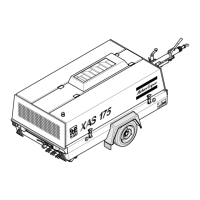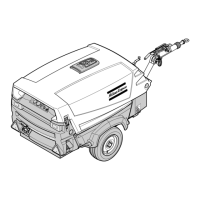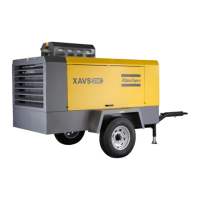8
6 Draining of condensate shall be performed regularly when vessel is in use.
7 Installation, design and connections should not be changed.
8 Bolts of cover and flanges may not be used for extra fixation.
Safety valve
All adjustments or repairs are to be done by an authorized representative of the valve
supplier.
Following checks must be carried out:
1 A check of the opening of the lifting gear, 1 or 2 times a year. This can be done by
screwing the cap of the valve anti-clockwise.
2 A check of the set pressure once a year according to the local regulations, if required.
This check may not be done with the compressor supplying the air pressure and must
be carried out on a proper test bench.
INJURY PREVENTION
1 Stationary housing guards are provided on all rotating or reciprocating parts not
otherwise protected and which may be hazardous to personnel. Machinery shall never
be put into operation, when such guards have been removed, before the guards are
securely reinstalled.
2 Do not open electrical cabinets, cubicles or other equipment while voltage is
supplied. If such cannot be avoided, e.g. for measurements, tests or adjustments,
have the action carried out by a qualified electrician only, with appropriate tools, and
ascertain that the required bodily protection against electrical hazards is applied.
3 Noise, even at reasonable levels, can cause irritation and disturbance which, over a
long period of time, may cause severe injuries to the nervous system of human
beings.
When the sound pressure level, at any point where personnel normally has to attend,
is:
below 70 dB(A): no action needs to be taken,
above 70 dB(A): noise-protective devices should be provided for people
continuously being present in the room,
below 85 dB(A): no action needs to be taken for occasional visitors staying a
limited time only,
above 85 dB(A): room to be classified as a noise-hazardous area and an obvious
warning shall be placed permanently at each entrance to alert
people entering the room, for even relatively short times, about
the need to wear ear protectors,
above 95 dB(A): the warning(s) at the entrance(s) shall be completed with the
recommendation that also occasional visitors shall wear ear
protectors,
above 105 dB(A): special ear protectors that are adequate for this noise level and
the spectral composition of the noise shall be provided and a
special warning to that effect shall be placed at each entrance.
4 Insulation or safety guards of parts the temperature of which can be in excess of 80
°C (175 °F) and which may be accidentally touched by personnel shall not be
removed before the parts have cooled to room temperature.
5 When hot parts have to be handled, e.g. shrink fitting, special heat-resistant gloves
shall be used and, if required, other body protection shall be applied.
6 If the working process produces fumes, dust or vibration hazards, etc., take the
necessary steps to eliminate the risk of personnel injury.
7 Before lifting machines, all loose parts which could be liable to fall down shall be
removed or secured; pivoting parts such as doors, towbars, etc. shall be safely
immobilized.
8 To lift heavy parts, a hoist of ample capacity, tested and approved according to local
safety regulations, shall be used.
9 When lifting machinery or parts with one or more lifting eyes, only hooks or shackles
meeting local safety regulations shall be applied. Never shall cables, chains or ropes
be applied directly on or through lifting eyes. Never allow sharp bends in lifting
cables, chains or ropes.
10 Lifting hooks, eyes, shackles, etc. shall never be bent and shall only have stress in
line with their design load axis. The capacity of a lifting device diminishes when the
lifting force is applied at an angle to its load axis.
11 For maximum safety and efficiency of the lifting apparatus all lifting members shall be
applied as near to perpendicular as possible. If required, a lifting beam shall be
applied between hoist and load.
12 When heavy parts are being lifted with a hoist, it is strictly forbidden to dwell or pass
under the load or in the space which is liable to be hit if the load or part of it should
topple over or come loose. Never leave a load hanging on a hoist. Lifting acceleration
and retardation shall be kept within safe limits.
13 A hoist has to be installed in such a way that the object will be lifted perpendicular. If
that is not possible, the necessary precautions must be taken to prevent load-
swinging, e.g. by using two hoists, each at approximately the same angle not
exceeding 30¡ from the vertical.
14 When using compressed air or inert gas to clean down equipment, do so with caution
and use the appropriate protection, at least safety glasses, for the operator as well as
for any bystander. Do not apply compressed air or inert gas to your skin or direct an
air or gas stream at people. Never use it to clean dirt from your clothes.
15 Before blowing compressed air or inert gas through a hose, ensure that the open end
is held securely, so that it cannot whip and cause injury.
16 When washing parts in or with a cleaning solvent, provide the required ventilation
and use appropriate protection such as a breathing filter, safety glasses, rubber apron
and gloves, etc.
17 Safety shoes should be compulsory in any workshop and if there is a risk, however
small, of failing objects, wearing of a safety helmet should be included.
18 If there is a risk of inhaling hazardous gases, fumes or dust, the respiratory organs
must be protected and, depending on the nature of the hazard, so must the eyes and
skin.
19. Remember that where there is visible dust, the finer, invisible particles will almost
certainly be present too; but the fact that no dust can be seen is not a reliable
indication that dangerous, invisible dust is not present in the air.
20 When using cartridge type breathing filter equipment, ascertain that the correct type of
cartridge is used and that its useful service life is not surpassed.

